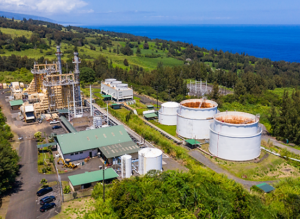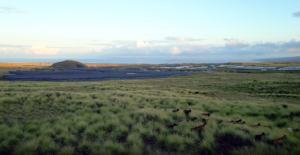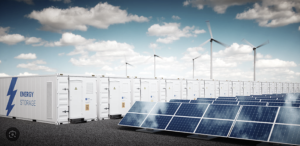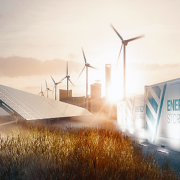Hawaiian Electric, Operating in Hawaii’s Best Interests?
Energy Alarms
Hawaii Island residents awoke to alarming news in February, and then again in March. Hawaiian Electric (aka HELCO) warned customers that the utility’s electricity services (which most County residents take for granted) would be facing rolling service blackouts and potential service disruptions of one or more hours in duration – and to be prepared for a loss in service.
Hawaiian Electric’s combustion turbine CT-1 unexpectedly tripped offline kicking off a local power crisis in the making. In the meantime, Hawaiian Electric’s Hill Plant Unit No. 5, Keahole CT-5, and Puna Steam Plant were unavailable due to maintenance and repairs – following a script for failure, the Feb-March service disruptions were one more example of a perfect storm, increasingly common within Hawaiian Electric’s service territories.
Local headlines followed; “Hawaiian Electric initiates rolling outages”, and in the following month, “Hawaiian Electric asking Big Island customers to conserve power due to down combustion power plants.”
The utility’s service reliability weaknesses are several, but it boils down to a primary dependency on combustion (firm) power plants designed to wastefully generate electricity at high-to-maximum energy levels around the clock, regardless of consumer demand. These firm power plants are combustion-based, meaning they produce power by burning various polluting source fuels. Regardless of a “renewable energy” label some of the utility’s plant operators promote who are not directly burning fossil fuels, the fuels these plants typically burn is neither sustainable or clean energy, and has recent history indicates, proving increasingly unreliable.
Hawaii Island’s Utility Experience
In the February service disruption, the first domino to fall was independent power producer Hamakua Energy, which unexpectedly tripped offline late in the afternoon of the 13th. The plant’s primary fuel is naphtha, considered the dirtiest of petrochemical fuels. Its composition and properties can vary significantly depending on its source and refining process. Naphtha’s higher content of aromatic and unsaturated hydrocarbons tends to produce more soot and emissions when burned, as is the case with Hamakua Energy. Optimizing naphtha as a fuel requires extensive purification and treatment to remove contaminants through extensive processes of filtration and coalescence.

In 2019, Hamakua partnered with Pacific Biodiesel to start using locally sourced biodiesel fuel. In this 90/10 fuel mix, bio-diesel is used to top-off the plant’s primary fuel, naphtha. The result is a slight reduction in the plant’s otherwise sole reliance on this imported and dirty fossil fuel. The flimsy PR case for this arrangement was billed as Hawaii’s energy independence and sustainability goals being fulfilled by Hamakua Energy’s contribution and marginally cleaned up through a minor addition of locally-produced biodiesel designed to reduce furnace fouling, emissions, and maintenance costs. The effectiveness of biodiesel added in this case has been described as lipstick-on-a-pig. Hawaii’s dirty energy power brokers point to Hamakua as the poster child for state-funded clean power incentives, funded by both taxpayers and ratepayers.
Optimize naphtha, as is the case with Hamakua, requires extensive purification and treatment to remove contaminants through processes like filtration and coalescence, an extensive pre-burn process promoted to reduce furnace fouling, emissions, and maintenance costs for the Hamakua Energy combustion power plant.
The February 2024 Hamakua Energy plant failure was attributed to mechanical issues, common with combustion power plants. Hamakua Energy (owned by Pacific Current), exclusively sells its power to HELCO, and through a state sanctioned power purchase agreement that runs until 2030. Hamakua is an example of firm energy on shaky ground.
Firm Energy, a not so firm assumption
The myth of so-called “firm power” combustion plants is twofold; first, they are essential to the fulfillment of Hawaii’s 24×7 electricity needs, and such, they are considered “firm power” as in always available, always on.
Hawaii Island’s largest firm power utility supplier went offline due to “significant mechanical issues”. Considering the operational complexity and costs to ratepayers and the planet, combustion power plants are subject to frequent operating failures and high maintenance cycles. As these power plants age, their complex operating designs become increasingly unreliable energy sources to operate. Their costly-to-maintain 24×7 operations are designed as essential grid power providers, but this role is threatened by improved and lower cost energy alternatives going well beyond the traditional operating role of firm combustion plants, and at lower cost. The trend is especially true for Hawaii as these plants approach the end of their operating life and are increasingly facing environmental and climate mitigation rules they are ill equipped to fulfill.
Hawaiian Electric’s overreliance on so-called “firm” energy suppliers are the by-product of last century grid power planning, assumptions, technologies, and operating practices increasingly out of synch with today’s changing climate realities, clean energy technology alternatives and replacement opportunities. Presently, it is a house of cards as recent utility-connected events on Maui, Oahu, and Hawaii Island have demonstrated.
The traditional definition of Firm Energy is the combination of a combustion power generating plant continuously operating at high rates of steady state energy production. Hawaiian Electric’s fragile power infrastructure and primary reliance on outdated combustion power plants sets the stage for operating circumstances leading to the Big Island service disruptions of February and March. In the case of the February 2024 Hamakua Energy plant failure, the plant normally generates 60 megawatts or nearly one-third of the typical peak demand of 180 megawatts on the entire island, further demonstrating the utilities’ over reliance on energy from a single supply point of potential failure.
Puna Geothermal Venture (PGV) is another technology example of Firm Energy and where Geothermal power intersect. The highly disruptive Kilauea eruption of 2018 put PGV out of the power generation business for several years. PGV not only failed to meet its original power reliability expectations, but the RPS power commitment it made to the utility, the PUC, and ratepayers. Over the following 5 five years (since 2018 and the Kilauea eruption) PGV has failed to meet production commitments to Hawaiian Electric. PGV’s highly-reduced power capacity today and since the eruption has peaked at 68% of its original agreement 25 megawatts of its earlier 38 MW power generation commitment to the utility.
PGV’s failings is one more bad bet example on this unique form of energy the utility has made on behalf of ratepayers. Utility energy choices are guided by a large and flexible plate of clean and dirty renewable combustion energy options which are served up by the state in what is increasing an outdated set of RPS rules guiding Hawaii’s energy future. While the utility’s poor power choices that rely on ratepayer bailouts of combustion options, also continue to produce rising energy costs. Couple to these rising costs are an increasing track record of power disruptions and greater power insecurity for Hawaii.
Hawaii’s state PUC must reconcile its representation of the public’s interest with the state’s renewable energy 2045 mandate, and in doing so, may find itself in the role of helping guide the state’s largest utility towards better energy supply choices, more winners and less ratepayer-funded losers. It’s reasonable to assume the PUC’s role could be more proactive in the fulfillment of the utility’s fundiacary responsibilities to the public, and its operating role as a legally sanctioned energy monopoly. The state’s present energy course, aside from good intentions, is one in which the utility decides, leaving most of Hawaii in a state of greater energy insecurity. Practice and policy which so far has failed to meet the state’s promised transition to clean energy economy.
Here Comes the Sun
Waikoloa Solar + Storage Community Energy Farm

Clean (zero emissions energy) in the form of wind and solar energy plants and in combination with battery and other energy storage options are now presenting highly competitive firm energy market alternatives to traditional, and costly biomass, WTE, and / or fossil-fueled combustion grid power options plants.
Beyond the obvious climate and cost benefits, these newer clean power + energy storage offer the same on-demand power provisioning benefits of traditional combustion plants, without the overhead and operating risks traditionally associated with combustion plants.
An added benefit to utilities engaged in 21st-century power provisioning is challenging the entire idea of traditional firm energy operations, as energy-wasteful and highly inefficient.
Grid-scale battery power storage releases only the power needed instantly to load balance grid demands with power supplies. Combustion plants simply produce power around the clock at fixed levels and then dump excess power not required to meet fluctuating consumer demand.
On the mainland, and perhaps Hawaii in the near future, today’s evolving and the variable clean energy (Solar /Wind) landscape with 24×7 load balancing storage will increasingly be beyond competitive and the least costly energy option in comparison to 20th century grid-scale energy options employed today, as exemplified today by obsolete combustion energy power plants supporting Hawaiian Electric’s overweighted investments in yesterday’s power generation.
The recent service activation of Hawaiian Electric’s AES Solar power plant in Waikoloa is an exception to the utility’s operating norms. The solar plant features a large array of panels connected to ample battery storage and represents a shining example of clean energy on-demand serving Hawaii Island ratepayers. The zero emissions energy power plant is also an excellent example of the benefits for 21st century clean power options at utility scale, and has proven to deliver to both ratepayers and the utility unprecedented energy operating savings.
With unsurpassed reliability and low operating cost, the AES plant produces (30 MW) for less cost to ratepayers, defying conventional ratepayer experience with an actual lowering of utility rates against a historic backdrop of ever increasing utility rates. Although Hawaiian Electric is reluctant to admit it, the AES solar plant also mitigated the overall recent power failure impacts on customers of the utility’s two most recent combustion plant power supply failures.
Questions increasingly being asked
Why doesn’t Hawaiian Electric modernize its energy technology thinking, planning, and prioritize more effective and efficient AES-like solar-storage energy supply options? Such planning would require the utility to consider retiring early some its costly and increasingly unreliable firm energy combustion supplier agreements, something unlikely based on the utility’s operating track record and priorities. The short answer to this question is more or less that ratepayers are footing the bill, not the utility, which presently has little incentive in executing needed 21st century energy reforms.
The utility’s public talking points, mostly amplified by a few powerful political agents in the state Senate is simple enough; we need firm power plants because firm power is our only practical option exiting our fossil fuel grid dependencies. The utility-inspired public misinformation campaign reasons that battery storage is only good for 2 and 4-hour durations (false), and that the wasteful status quo of 24×7 full-throttle firm power combustion power plants are the state’s only way forward. These talking points supporting the utility present track record and trajectory are false assumptions and full of half-truths, but serve as convenient public talking points.
Utility grid-scale energy storage is not limited by today’s battery technology, but is actually dictated by scale and the utility’s RFP requirements. The more batteries, the greater storage capacity, and the greater power duration to load balance the grid, day or night – without pollution and with greater reliability. Battery storage requirements and limitations are dictated by the utility, not limits in technology of performance. Larger battery deployments equal longer on-demand power storage, available as needed day or night, and without technology limitations.
Utilities tend to limit the scale of RFP storage requests for a variety of reasons which have less to do with the technology transformation opportunities, more to do with business and profit priorities. It is true requesting smaller battery storage deployments is cheaper, but that misses the point entirely in the larger cost and performance designed to serve ratepayers interests.
Clean, Low Cost Energy take a back seat to Hawaiian Electric’s energy priorities
Energy storage deployment in 2023 set a record globally and more than doubled in the U.S., according to Bloomberg NEF’s Energy Storage Market Outlook. The report credited the rapid growth in energy storage to government targets and incentives, as well as the growing need to shift energy from the time of generation to times of peak demand. In addition to improving overall grid reliability, using energy storage to “shave” peak demand can also help insulate utilities from volatility in the pricing of electricity. not necessarily a problem in Hawaii’s insulated energy market, but helpful nonetheless.
There is an increasing drumbeat within our island communities, one which cherry-picks energy facts regarding Hawaii’s transition to clean energy vs. the status quo of burning fossil fuels, and one which favors complex and expensive combustion energy options in a variety of forms; organic and inorganic fuel options from green waste to food waste, to trees and to WTE toxic and non-toxic trash burning to produce power. In all cases, these so-called renewable energy fuels must first be burned in a variety of steps to create steam, which in turn spins turbines, and then finally electricity destined for the grid.
Compared to solar (without any moving parts, zero air and climate pollution, and low maintenance) and a source of unparalleled clean energy source that is free-to-all (the Sun), and wind turbines which have few moving parts and a low level of periodic maintenance compared to the complexities of combustion plant operations with their extensive and expensive maintenance requirements it should be an easy choice for utilities seeking greater cost performance and reliability. In short, solar and wind in combination with today’s energy storage options offer ratepayers and utilities alike greater service reliability at a lower cost – period.
Today’s energy storage technologies serve a crucial role balancing electricity supply with demand

“Combustion is the problem – when you’re continuing to burn something, that’s not solving the problem,” says Prof Mark Jacobson. The Stanford University academic has a compelling pitch: the world can rapidly get 100% of its energy from clean and renewable sources with “no miracles needed”.
Wind, water and solar can provide plentiful and cheap power, he argues, ending the carbon emissions driving the climate crisis, slashing deadly air pollution and ensuring energy security.
Expanding storage options are no longer limited to batteries and pumped hydroelectric, as compressed air, flywheels, and thermal storage systems enter various stages of commercialization.
Altogether, an expanding base of energy storage technology options are enabling innovative utilities to store low cost solar and wind excess electricity during periods of low demand and match peak production for later release in the fulfillment of on demand consumer power requirements.
Utility scale battery storage technology is not limited by technology, rather by the scale of its application in augmenting and replacing higher cost and higher risk firm combustion energy options.




Thanks for quoting Professor Mark Jacobson! – “No Miracles Needed”…indeed, as we have proof already with Waikoloa Solar.
Now if we could only incentivize Industrial/commercial/public buildings to go all out with Roof Top Solar in Hilo and Kona…and for Hilo I can think of no better ‘stand-by (battery) storage’ site than the present Hu Honua orphaned white elephant cage! 😉